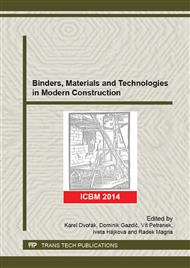[1]
Brandštetr, J., Polcer, J., Krátký, J., Holešinský, R., Havlica, R.: Possibilities of the use of isoperibolic calorimetry for assessing the hydration behavior of cementitious systems. 2001. Cement and Concrete Research, 31 (6), pp.941-947.
DOI: 10.1016/s0008-8846(01)00495-1
Google Scholar
[2]
Hela, R., Zach, J., Sedlmajer, M.: Possibilities of regulation of temperature in concrete during hydration by means of selection of suitable input materials. 2014. Applied Mechanics and Materials, 507, pp.199-203.
DOI: 10.4028/www.scientific.net/amm.507.199
Google Scholar
[3]
Topolář, L., Šimonová, H., Rovnaník, P., Schmid, P.: The effect of the carbon nanotubes on the mechanical fracture properties of alkali activated slag mortars. 2014. Applied Mechanics and Materials, 617, pp.243-246.
DOI: 10.4028/www.scientific.net/amm.617.243
Google Scholar
[4]
Pazdera, L., Topolar, L.: Application acoustic emission method during concrete frost resistance. 2014. Russian Journal of Nondestructive Testing, 50 (2), pp.127-131.
DOI: 10.1134/s1061830914020065
Google Scholar
[5]
Topolář, L., Pazdera, L.: Acoustic emission in protected and non-protected concrete during the first 24 hours. 2014. Applied Mechanics and Materials, 578-579, pp.1149-1152.
DOI: 10.4028/www.scientific.net/amm.578-579.1149
Google Scholar
[6]
Matysík, M., Plšková, I., Chobola, Z.: Estimation of impact-echo method for the assessment of long-term frost resistance of ceramic tiles. 2014. Advanced Materials Research, 1000, pp.285-288.
DOI: 10.4028/www.scientific.net/amr.1000.285
Google Scholar
[7]
Šimonová, H., Kucharczyková, B., Havlíková, I., Seitl, S., Keršner, Z.: Complex evaluation of fatigue tests results of plain C30/37 and C45/55 class concrete specimens. 2014. Key Engineering Materials, 592-593, pp.801-804.
DOI: 10.4028/www.scientific.net/kem.592-593.801
Google Scholar
[8]
Korenska, M., Manychova, M., Pazdera, L., Topolar, L.: Monitoring of the damage in stone blocks by means of non-destructive methods. 2014. Key Engineering Materials, 592-593, pp.545-548.
DOI: 10.4028/www.scientific.net/kem.592-593.545
Google Scholar
[9]
Korenska, M., Manychova, M., Pazdera, L.: Experimental study of the nonlinear effects generated in a concrete structure with damaged integrity. 2013. Russian Journal of Nondestructive Testing, 49 (9), pp.530-537.
DOI: 10.1134/s1061830913090040
Google Scholar
[10]
Miroslav, L., Kusak, I., Chobola, Z.: Dielectric properties of concrete specimens after heat stress.
Google Scholar
[11]
2014. Applied Mechanics and Materials, 446-447, pp.1389-1394.
Google Scholar
[12]
Matysík, M., Topolář, L., Daněk, P., Šimonová, H., Vymazal, T., Plšková, I.: An experimental study on acoustic emission signals during the three-point bending fracture test. 2014. Advanced Materials Research, 1000, pp.281-284.
DOI: 10.4028/www.scientific.net/amr.1000.281
Google Scholar
[13]
Tupý, M., Štefková, D., Sotiriadis, K., Krmíček, L., Carbol, L., Petránek, V.: Recycled poly(vinyl butyral) used as a barrier to prevent mortar carbonation. 2014. Advanced Materials Research, 1000, pp.28-34.
DOI: 10.4028/www.scientific.net/amr.1000.28
Google Scholar
[14]
Chobola, Z., Štefková, D., Šamárková, K.: The use of acoustic methods for non-destructive testing of high-temperature-degraded cement-based composite. 2014. Applied Mechanics and Materials, 446-447, pp.1395-1399.
DOI: 10.4028/www.scientific.net/amm.446-447.1395
Google Scholar
[15]
Vymazal, T., Žižková, N., Misák, P.: Prediction of the risks of design and development of new building materials by fuzzy inference systems. 2009. Ceramics - Silikaty, 53 (3), pp.216-224.
Google Scholar
[16]
Misák, P., Kucharczyková, B., Vymazal, T., Danek, P., Schmid, P.: Determination of the quality of the surface layer of concrete using the tpt method and specification of the impact of humidity on the value of the air permeability coefficient. 2010. Ceramics - Silikaty, 54 (3), pp.290-294.
Google Scholar
[17]
Kusák, I., Luňák, M., Chobola, Z.: Non-destructive tracking of structural changes of concrete mixtures during thermal stress. 2014. Applied Mechanics and Materials, 617, pp.152-155.
DOI: 10.4028/www.scientific.net/amm.617.152
Google Scholar
[18]
Vanek, J., Dolensky, J., Chobola, Z., Lunak, M.: Microplasma analysis and noise spectroscopy of c-Si solar cells. 2012. ECS Transactions, 40 (1), pp.177-185.
DOI: 10.1149/1.4729101
Google Scholar
[19]
Plšková, I., Chobola, Z., Matysík, M.: Assessment of ceramic tile frost resistance by means of the frequency inspection method. 2011. Ceramics - Silikaty, 55 (2), pp.176-182.
Google Scholar
[20]
Zach, J., Kminová, H., Horky, O., Brozovsky, J.: Determination of intensity of hydration heat development of silicate binders. 2005. 8th International Conference of the Slovenian Society for Non-Destructive Testing: Application of Contemporary Non-Destructive Testing in Engineering, pp.375-382.
Google Scholar
[21]
Šiler, P., Kolářová, I., Krátký, J., Havlica, J., Brandštetr, J.: Influence of superplasticizers on the course of Portland cement hydration. 2014. Chemical Papers. 68(1). pp.90-97.
DOI: 10.2478/s11696-013-0413-x
Google Scholar


